Shuttle XPC SN95G5
Overview
If you haven't already seen several reviews of the SN95G5, we'd be pretty amazed. Released almost a year ago, the SN95G5 was the first socket 939 SFF to market. Sometimes that's a bad thing, but it has actually held up quite well compared to some of the newer releases. We've already looked at Shuttle's SN25P unit, and while it improves on the SN95G5 in a number of areas, there are still reasons to consider the older model.Aesthetics
We'll start with the outward appearance. Tastes will differ, but we feel that the G5 chassis is still one of the best looking SFF designs that we've seen. It's small, sleek, and the brushed aluminum finish on the covers as well as the front panel has a refined look that is difficult to beat. The G5 chassis is also one of the smallest - if not the smallest - fully functional barebones setups. Sure, you can get a smaller computer like the Mac Mini, but you can't upgrade a Mini to run with a high-end graphics card and processor. The font panel also features very subdued lighting, and chrome accents add a bit of visual flare.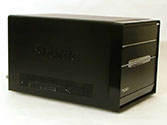 |
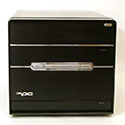 |
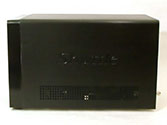 |
| Click on images to enlarge. | ||
As a size comparison, the G5 is 1 cm less in length than most other SFFs - not a big deal, but it's still a difference. The P series Shuttle chassis is 1 cm longer and wider, as well as 3.5 cm taller. There are reasons for the increased size, which you'll see in the features section in a moment. The ST20G5 is a very similar design, with the major difference being the chipset and features. It also comes in silver rather than black by default, which some people will prefer. Overall, though, we think that the G5 design is perfect for a variety of uses, including an office setting.
Features
|
Shuttle XPC SN95G5v2
|
||
| Dimensions | (w)200 mm x (h)185 mm x (d)310 mm | |
| CPU Support | AMD Socket 939 up to FX-55
|
|
| Memory Support | PC1600/PC2100/PC2700/PC3200 up to 2GB; 2 DIMM slots | |
| Motherboard | FN95 (proprietary) NVIDIA nForce3 Ultra Chipset 1X-5X (200-1000MHz) HyperTransport 8-bit/8-bit to 16-bit/16-bit HT Width |
|
| Expansion Slots | 1 x 4X/8X AGP; 1 x PCI | |
| Power Supply | 240W Silent X Power Supply 2 x 4-pin Molex; 1 x 4-pin FDD; 3 x SATA 1 x 4-pin ATX12V; 1 x 20-pin ATX |
|
| Internal Connections | 2 x SATA; 1 x IDE; 1 x FDD; 1 x LPT | |
| Audio | Realtek ALC655 5.1 channel | |
| LAN | 1 x 10/100/1000 Mbps (NVIDIA + PHY) | |
| Drive Bays | 1 x 3.5 External (FDD/HDD) 1 x 3.5 Internal (HDD) 1 x 5.25 External (CD/DVD) |
|
| Front I/O | 2 x USB 2.0 1 x IEEE1394 (4pin) MIC, Head-phone Power & Reset buttons Power on & HDD LED indicators |
|
| Rear I/O | 2 x USB 2.0 1 x IEEE1394 (6pin) PS/2 KB, PS/2 Mouse Serial port RJ-45 LAN Port (10/100/1000Mbps) Line-in, S/PDIF In Optical S/PDIF Out Coax Center/Sub, L/R Front, L/R Rear |
|
| Overclocking | CPU 200-280; CPU Ratio 4X-Max; Northbridge 1.60V-1.70V Vcc 0.800-1.700V; DDR Auto, 2.70-2.90V |
|
| Extras | ICE cooling | |
| Full Image Set | Shuttle SN95G5v2 Pictures (3.4MB) | |
| Manufacturer Link | Shuttle XPC SN95G5 | |
The feature list of the SN95G5 covers all of the requisite areas. Firewire, USB, GbE, and audio ports are all available. S/PDIF optical in and out ports are also included on the rear, along with an S/PDIF coaxial out connection. The remainder is pretty standard for a well-equipped SFF. There are two DIMM slots, an AGP and PCI slot, two SATA and IDE connections, and a floppy connection. The chassis has room for one internal 3.5" HDD, along with external 3.5" and 5.25" drive bays. The 3.5" external bay is unoccupied, so you can choose to either leave it empty or fill it with a floppy, flash card reader, or a second hard drive. That's pretty much it as far as expansion features, which isn't too surprising given the size of the case.
There are a few items worthy of further discussion, however. First is the choice of platform. While PCI Express is getting all of the news coverage these days, AGP is not dead yet. For those who spent several hundred dollars on a (formerly) high-end AGP graphics card, AGP is still perfectly acceptable. Going forward, PCIe cards will come out first, with bridge chips being used to allow backwards compatibility with AGP. (The 6600GT and X800XL are both prime examples of what we imagine will be the future trend in graphics card releases.) If you're building a new PC from scratch, AGP probably isn't the best choice; for those looking to assemble computers out of spare parts with a few new purchases, AGP still has a lot of untapped performance. The PCI slot is at present even more useful, as we have yet to see any PCIe X1 expansion cards. That will change in the future, but for now, it is possible to get sound cards, TV tuners, or a variety of other cards that will run in a PCI slot, where an X1 PCIe slot would sit empty.
Moving on to the CPU socket, we've already mentioned that socket 939 is our present SFF platform of choice. The new dual-core Pentium D is a more attractive alternative than the old Prescott, but for the price, performance, and heat characteristics, we still recommend socket 939. Heat dissipation is a much bigger concern in a SFF case, after all. What's nice about socket 939 is that it isn't a dead end, as a BIOS update should provide support for the (now shipping) dual-core Athlon 64 X2 processors. We have heard that a BIOS update enabling X2 support is available for the SN95G5, but we've also heard that Winchester and Venice cores require the SN95G5v3 (we're testing the SN95G5v2). If you can only get X2 and 90nm chip support with the v3 model, there are going to be some disappointed people. Shuttle in North America appears to be willing to swap SN95G5v2 for v3 in North America, but you'll have to talk to them on your own. (If you have tried this, please email me the results - did they swap without difficulty? How much did it cost? I'll include any details that I can get in the follow-up article.)
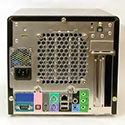 |
 |
| Click on images to enlarge. | |
There are a few minor concerns with the SN95G5, as usual. One is the rear audio ports: they're all green and the icons/text are difficult to read for those with less than stellar eyesight. Almost every motherboard/SFF that we've seen in recent years has color-coded the audio ports, and we're a little baffled that Shuttle didn't do this on their G5 models. The good news is that in contrast to several other units, we didn't encounter any issues with the onboard audio on the SN95G5. The rear ports were as clean as any that we've tested, and we didn't notice any noise on the front headphone port either. There may have been a very small amount of noise on the front port, but if so, it wasn't enough to be distracting. We do wish that the integrated audio were of the HD variety, but as we'll discover with the ST20G5, HD audio doesn't necessarily mean that it's good HD audio.
Another possible cause for concern is the lack of a flash memory reader. (The new P series includes a flash reader, and the older G4 chassis came with one as well.) The Soltek and G5 SFFs are the only models without a reader in this roundup. We're not too worried about this omission, however, as those who really want such support can purchase a reader from Shuttle or elsewhere. Still, given the price of the Shuttle compared to competitors' offerings (around $280 these days), some people may not be as ambivalent as we are.
In fact, a lack of expansion possibilities is the biggest drawback that can be levied against the SN95G5. One HDD, one optical drive, and one 3.5" external bay makes it one of the most limited SFF designs around. The 240W power supply is also rather small, although it handled our SFF configuration without incident. We're saying this not as a problem with the G5, but as something to be aware of should you purchase such a case - many other SFFs have this same set of expansion options. A design decision was made, and expansion was limited in favor of being smaller. The only way to further reduce the size would be to use 1.8"/2.5" laptop HDDs and a half-height optical drive. We might see such a design in the future, but laptop drives are quite a bit slower, so it's not a change that could be made without consequences. Those who are more concerned with expansion possibilities can turn towards the SN25P, as it is pretty much on the other end of the expansion spectrum for SFFs.


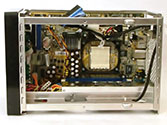








29 Comments
View All Comments
JarredWalton - Wednesday, August 10, 2005 - link
So I spoke too soon. After finishing this article, I just happend to come across http://www.newegg.com/Product/Product.asp?Item=N82...">the new Aopen 939 SFF. That actually looks pretty promising, though the IGP isn't going to beat the ST20G5 that I can see (no DVI port). Time to put in a request for that unit....rqle - Wednesday, August 10, 2005 - link
Price of these SFF are getting quite pricey lately. So much to the point when you add the cpu, hard drive, memory, video card, optical drive AND LCD it will comes very close to the price of a good high end laptop on a good day. Dell 17inch 9300 w/6800 on a VERY good sale day comes just over the price of these SFF 'system.' Big fan of these SFF, but prices should be a little bit more reasonable for me to buy again.JarredWalton - Wednesday, August 10, 2005 - link
I agree with you on a lot of that, but a SFF with a 19" (or larger) LCD and a 6800GT/X800XL is pretty much going to stomp all over any similarly priced laptop. There's basically a $150 price premium to get a high-end SFF case, which is going to prevent many from buying. Still, some people buy $200 cases just because they look nice, so it's all a matter of taste.If you need portability, though, there are very few options other than getting a laptop. Personally, laptops and gaming are something I just don't care about. I'd get a cheap laptop for the office work I do and then keep a second system at home for any gaming. Some of course feel otherwise, but laptop keyboards and such just don't do it for me.
R3MF - Wednesday, August 10, 2005 - link
love it.BigT383 - Wednesday, August 10, 2005 - link
I have a first-generation SN95G5. I bought it thinking that since it's socket 939 I'd be able to upgrade to dual-core when it came out.Apparently this isn't the case, but I haven't seen anybody say they've tried it yet- so far there seem to be only rumors.
So I know this is a weird request but what I'd like to see right now is an article testing a CPU like the Athlon X2 4400+ on the three different versions of the SN95G5.
I can understand that X2s need a bios update, but the physical motherboard shouldn't be holding me back, right?
dcuccia - Thursday, August 18, 2005 - link
X2 support for the SN25P w/o USB2 issues is now available through a BIOS upgrade:http://www.shuttle.com/share/fae/hq/download/bios_...">http://www.shuttle.com/share/fae/hq/download/bios_...
JarredWalton - Thursday, August 18, 2005 - link
Thanks, I made a quick comment on the SN25P page to mention this.JarredWalton - Wednesday, August 10, 2005 - link
I'm going to be dropping an X2 3800+ into the SN95G5v2 just to see what happens. I'll try to get some official word from Shuttle on the matter as well. I really have no idea what the SN95G5v1 will support. I think the main change between it and v2 was a switch from an 80mm fan to a 92mm fan.Zirconium - Wednesday, August 10, 2005 - link
I love the roundup articles. I find them to be the most useful because they allow you to hone in on what you are looking for quickly, and then you can go to other sites and check the reviews that are solely for the products you are looking for.That said, one thing I'm interested is the quality of the integrated graphics on these computers. I have an SK41G and I could tell the difference between the quality of the built-in graphics and the AIW Radeon 7500 that is currently in it. When the integrated graphics were hooked up to a TV (I tried two) you could notice bands moving up the TV.